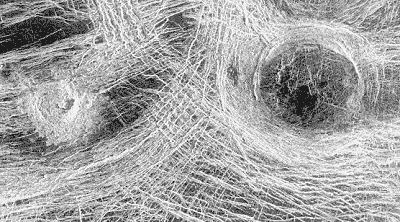Now we have looked in detail at the earth, we compare with Venus. As the article below indicates, the surface of this planet has not developed plates, and as a result the interior heat has dramatically different ways of rising to the surface compared with the earth.
From Geology with Andrew Alden, http://geology.about.com/library/weekly/aa060803a.htm
| The Baffling Geology of Venus |
Introducing the mysteries of Venus geology
Venus has always been a mysterious world. The earliest observers had two names for it, the Morning Star and the Evening Star. Telescopes showed only a brilliant white disk, thick clouds hiding all trace of the planet's surface. More recently radar mappers, landers and other spacecraft studies have lifted Venus's veil to science, but today it remains mysterious.
 |
| Venus's surface. NASA image. |
Venus is almost a twin of Earth in terms of size, mass and composition. It's only slightly smaller, formed in the same neighborhood of the solar system, and has a large iron core and rocky silicate mantle. Like Earth, its crust is largely basalt (though in our case the basalt is almost all hidden by the ocean).
The key to the geology of Venus seems to be its heat. Start with its thick, choking atmosphere of nearly pure carbon dioxide. Air pressure on Venus's surface is about 90 times Earth's, the same as it would be a full kilometer under the ocean. This greenhouse gas is so effective at trapping the sun's heat that the ground of Venus is literally hot as a furnace, reaching around 450 degrees C (or 725 K) at the equator, year round. There is no water anywhere except a little high in the atmosphere. The bright clouds are composed of sulfuric acid.
The crust of Venus appears to be almost entirely volcanic and basaltic. There is nothing there like Earth's continents—no granitic rocks at all, high in silicon and oxygen. Venus instead has large, bizarre fractured structures called coronae ("crowns") and tesserae ("mosaic chips"). There is no large-scale motion of the crust, no plate tectonics. On Earth, plate tectonics is driven by surface cooling, which makes the plates denser than the soft layer of rock beneath them. On Venus the surface cannot cool and the crust cannot overturn.

This synthetic-aperture radar
image shows a crater on the left, a small corona on the right, and the profusion of
fractures and wrinkle ridges that cover all of Venus. (c) 2003 Andrew Alden, licensed to
About, Inc.; source: Magellan Image Browser
Nevertheless, the presence of lava everywhere we look means that deep heat from Venus's mantle and core can melt rocks and cause that magma to erupt. The eruptions appear random, unlike the organized lines and arcs of volcanoes on Earth. Is this all that ever happens? The way to answer that question is to study the geologic history of the planet in detail.
The backbone of planetary dating is crater counts. We have a good idea, from studying the other planets, of how old a surface is based on the number of craters it has. On Venus there are about 1000 craters, an unusually small number. The crater statistics tell us that although the planet is 4.6 billion years old, nothing on its surface is older than roughly 0.5 billion years. Almost all of Venus's history is a blank slate.
It looks as if half a billion years ago, all of Venus's surface was replaced. Within perhaps one-tenth that time, maybe 50 million years, almost all of the features we see were emplaced: highly deformed tesserae first, then large plains of lava heavily wrinkled in huge ridges. The lava flows that have occurred since that early period are fairly smooth and undisturbed. It is the picture of a thin, soft crust quickly growing harder and thicker as the mantle roiled beneath it. That's one working hypothesis.
It's easy to picture a gigantic planetary cycle in which Venus "boils over" and replaces its surface with a new lava crust. It's harder to prove such a model, or to say how fast it happens. Only with more information can we make progress. But there are no plans yet to return to Venus. For now we must work with the data we have—plus powerful computer simulations. Those suggest that Venus's wrinkled face may be due to hot flashes from above and below.
| The Hot Squeeze |
Venus may have been wrinkled by its broiling atmosphere
The radar mapping of Venus's surface has laid bare its mysterious wrinkled crust and given us hints about the mantle beneath. We also have a bit of insight into the iron core from the planet's magnetic field—there is none. That means the core is not stirring. For stirring, or convection, to occur there must be heat below and cold above, just like the pot of water boiling on your stove. But Venus is hot all the way up to the surface.
 |
Moreover, Venus may not have a solid inner core as Earth does. On Earth, energy is released as iron freezes onto the inner core, stirring the liquid metal above it. If Venus lacks this source of heat below and is not strongly cooled from above, then its core must be too sluggish to generate a magnetic field.
Earth's geomagnetic field protects us from a great deal of high-energy radiation from the sun. On Venus, the atmosphere takes the brunt of that same radiation—more of it, actually, since the sun is closer. In fact the more we study Venus, using computer simulations, the more the atmosphere matters. It is a most unusual greenhouse.
Carbon dioxide (CO2) makes up 96 percent of Venus's dense atmosphere, retaining so much of the sun's energy that any ocean the planet once had was long ago boiled away. But two trace gases, water vapor and sulfur dioxide, have powerful effects too. The reason is that CO2 isn't a perfect greenhouse—it allows certain wavelengths of radiation through. Water vapor and sulfur gases plug those holes. These gases are released during volcanic eruptions, and if there are enough eruptions Venus gets a really bad fever.
Physical and chemical processes slowly remove the volcanic gases over millions of years. Water vapor breaks down under solar radiation into oxygen and hydrogen, and the hydrogen escapes into space. That's how Venus lost its water ages ago. The sulfur gases react with the rocks on Venus's surface and leave the atmosphere. But in the meantime, the temperature rises significantly, 100 degrees or more. After a few million years the heat penetrates the crust to the upper mantle, bringing it closer than ever to melting. This feedback encourages more eruptions.
Researchers look at the massive eruptions of 500 million years ago, which resurfaced the whole planet, and ask what the volcanic gases from that cataclysm did. Their models suggest that the pulse of greenhouse heat actually expanded the crust, warping it to create the wrinkle ridges covering most of the surface. As the atmosphere cooled, the crust shrank to open cracks elsewhere on Venus. Smaller eruptions have similar but lesser effects.
One might ask how the big crustal turnover happened. As with other planetary puzzles there are two possible ways, one from below and one from above. On Earth, the largest continental plates tend to trap heat beneath them, eventually causing them to break up. If Venus is considered a "one-plate" planet, then such a breakup from below could start with one large eruption. Reinforced by atmospheric feedback, the disturbance would spread to affect everything at once.
The alternative is that fresh greenhouse gases enter the atmosphere from above, from large comets. Simulations suggest that comet collisions would deposit water vapor without blasting the atmosphere away. Under that water vapor blanket, the rocks of Venus would roast and soften to the melting point just as they might when heat builds up below. Either way, this strange world would erupt itself a fresh new face.